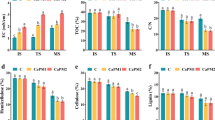Abstract
Residual cellulose acetate (CA) films with initial degree of substitution (DS) values of 1.7 and 2.5 (CA DS-1.7 and DS-2.5) were recovered from a simulated thermophilic compost exposure and characterized by gel permeation chromatography (GPC), proton nuclear magnetic resonance (1H NMR), and scanning electron microscopy (SEM) to determine changes in polymer molecular weight and DS and to study microbial colonization and surface morphology, respectively. During the aerobic degradation of CA DS-1.7 and CA DS-2.5 films exposed for 7 and 18 days, respectively, the number-average molecular weight (M n) of residual polymer decreased by 30.4% on day 5 and 20.3% on day 16, respectively. Furthermore, a decrease in the degree of substitution from 1.69 to 1.27 (4-day exposure) and from 2.51 to 2.18 (12-day exposure) was observed for the respective CA samples. In contrast, CA films (DS-1.7 and DS-2.5) which were exposed to abiotic control vessels for identical time periods showed no significant changes inM n and DS. SEM photographs of CA (DS-1.7 and DS-2.5) film surfaces after compost exposures revealed severe erosion and corresponding microbial colonization. Similar exposure times for CA films in abiotic control vessels resulted in only minor changes in surface characteristics by SEM observations. The conversion of CA DS-1.7 and DS-2.5 to CO2 was monitored by respirometry. In these studies, powdered CA was placed in a predigested compost matrix which was maintained at 53°C and 60% moisture content throughout the incubation period. A lag phase of 10- and 25-day duration for CA DS-1.7 and DS-2.5, respectively, was observed, after which the rate of degradation increased rapidly. Mineralization of exposed CA DS-1.7 and DS-2.5 powders reported as the percentage theoretical CO2 recovered reached 72.4 and 77.6% in 24 and 60 days, respectively. The results of this study demonstrated that microbial degradation of CA films exposed to aerobic thermophilic laboratory-scale compost reactors not only results in film weight loss but also causes severe film pitting and a corresponding decrease in chainM n and degree of substitution for the residual material. Furthermore, conversions to greater than 70% of the theoretical recovered CO2 for CA (DS 1.7 and 2.5) substrates indicate high degrees of CA mineralization.
Similar content being viewed by others
References
C. S. Gong, L. F. Chen, M. C. Flickinger, and S. Tsao,Adv. Biochem. Eng. 20 93 (1981).
E. K. Yu and J. N. Saddler,Trends Biotechnol. 3 100 (1985).
R. T. Bogan and R. T. Brewer,Encyclop. Polym. Sci. Eng. 3 158 (1988).
E. T. Reese,Indust. Eng. Chem. 49 89 (1957).
K. M. Downing, C. S. Ho, and D. W. Zabriskie,Biotechnol. Bioeng. 29 1086 (1987).
T. E. Timell,Wood Sci. Technol. 1 45 (1967).
E. Luthi, N. B. Jasmat, and P. L. Berquist,Appl. Microbiol. Technol. 34 214 (1990).
H. Lee, R. J. B. To, R. K. Latta, P. Biely, and H. Schneider,Appl. Environ. Microbiol. 53 2831 (1987).
K. Poutanen and J. Pils, inPlant Cell Wall Polymers—Biogenesis and Biodegradation, N. G. Lewis and M. G. Paice, eds. (American Chemical Society, Washington, DC, 1989), p. 629–640.
J.-D. Gu, D. Eberiel, S. P. McCarthy, and R. A. Gross,J. Environ. Polym. Degr. 1 143 (1993).
R. A. Gross, J.-D. Gu, D. T. Eberiel, M. Nelson, and S. P. McCarthy, inBiodegradable Polymers and Packaging, C. Ching, D. Kaplan, and E. Thomas, eds. (Technomic, Lancaster, PA, 1993), p. 257–279.
J.-D. Gu, S. P. McCarthy, G. P. Smith, D. Eberiel, and R. A. Gross,Polym. Mater. Sci. Eng. 67 230 (1992).
J.-D. Gu, M. Gada, G. Kharas, D. Eberiel, S. P. McCarthy, and R. A. Gross,Polym. Mater. Sci. Eng. 67 351 (1992).
M. Nelson, S. P. McCarthy, and R. A. Gross,Polym. Mater. Sci. Eng. 67 351 (1992).
M. Nelson, S. P. McCarthy, and R. A. Gross, in preparation.
C. M. Buchanan, R. M. Gardner, and R. J. Komarek,J. Appl. Polym. Sci. 47 1709 (1993).
V. W. Goodlett, J. T. Dougherty, and H. W. Patton,J. Polym. Sci. (Part A-1)9 155 (1971).
J.-D. Gu, S. Coulter, D. Eberiel, S. P. McCarthy, and R. A. Gross,J. Environ. Polym. Degr. 1 301 (1993).
P. Biely, C. R. MacKenzie, J. Puls, and H. Schneider,Bio/Technology 4 731 (1986).
K. K. Y. Wong, L. U. L. Tan, and J. N. Saddler,Microbiol. Rev. 52 305 (1988).
Author information
Authors and Affiliations
Additional information
Guest Editor: Dr. Graham Swift, Rohm & Haas.
Rights and permissions
About this article
Cite this article
Gu, JD., Eberiel, D., McCarthy, S.P. et al. Degradation and mineralization of cellulose acetate in simulated thermophilic compost environments. J Environ Polym Degr 1, 281–291 (1993). https://doi.org/10.1007/BF01458295
Issue Date:
DOI: https://doi.org/10.1007/BF01458295




